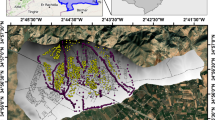Abstract
We develop and compare methods for assessing the risk that unexploded ordnance (UXO) have been missed following prioritized digging. A random compliance sampling approach has been suggested for UXO risk assessment, and we extend this approach to account for the bias in prioritized digging, thereby reducing the number of excavations required to test for outlying UXO. We then discuss and compare methods for identification of outliers to the distribution of UXO via generative models of the receiver operating characteristic (ROC). Next, we consider how seeded items emplaced for quality control can be used to increase confidence in the classification process, and we model this process by constraining the ROC model. Finally, we turn to the problem of identifying novel, or unique, UXO with prioritized validation digs. We propose a metric that combines features of the geophysical model estimated for each detected target to identify novel UXO. The metric requires no prior information about the UXO present at a site.












Similar content being viewed by others
References
Bell T, Barrow B, Miller J, Keiswetter D (2001) Time and frequency domain electromagnetic induction signatures of unexploded ordnance. Subsurf Sens Technol Appl 2:153–175
Beran L (2014) Hypothesis tests to determine if all true positives have been identified on a receiver operating characteristic curve. J Appl Stat 41(6):1332–1341
Beran L, Zelt B, Pasion L, Billings S, Kingdon K, Lhomme N, Song LP, Oldenburg D (2012) Practical strategies for classification of unexploded ordnance. Geophysics 78:E41
Fog A (2008) Calculation methods for Wallenius’ noncentral hypergeometric distribution. Commun Stat 37(2):258–273
Hanley JA (1988) The robustness of the “binormal” assumptions used in fitting ROC curves. Med Decis Mak 8:197–203
Hanley JA, McNeil BJ (1982) The meaning and use of the area under a receiver operating characteristic. Radiology 143:29–36
Hathaway J, Gilbert R, Wilson J, Pulsipher B (2009) Evaluation of spatially clustered ordnance when using compliance sampling surveys after clean-up at military training sites. Stoch Environ Res Risk Assess 23:253–261
Liese F, Miescke KJ (2008) Statistical decision theory: estimation, testing, and selection. Springer, New York
Metz CE, Herman BE, Shern J (1988) Maximum likelihood estimation of reciever operating characteristic (ROC) curves from continuously-distributed data. Stat Med 17:1033–1053
Pasion LR, Oldenburg DW (2001) A discrimination algorithm for UXO using time domain electromagnetic induction. J Environ Eng Geophys 6:91–102
Pasion LR, Zelt BC, Kingdon KA, Beran LS (2012) Feature extraction and classification of EMI data, Camp Beale, CA, ESTCP Project MR-201004. Technical report, ESTCP
Press WH, Flannery BP, Teukolsky SA (1992) Numerical recipes in C. Cambridge University Press, Cambridge
Scholz FW, Stephens MA (1987) K-Sample Anderson–Darling tests. J Am Stat Assoc 82(399):918–924
Shubitidze F, Barrowes B, Shamatava I, Fernandez JP, O’Neill K (2011) The ortho-normalized volume magnetic source technique applied to live-site UXO data: inversion and classification studies. SEG Tech Program Expand Abstr 30(1):3766–3770
Walsh S, Anderson K, Hathaway J, Pulsipher B (2011) A Bayesian approach to monitoring and assessing unexploded ordnance remediation progress from munitions testing ranges. Stoch Environ Res Risk Assess 25(6):805–814
Acknowledgments
This work was supported by Strategic Environmental Research and Development Program Project MR-2226.
Author information
Authors and Affiliations
Corresponding author
Appendix: Metrics for identifying novel targets of interest
Rights and permissions
About this article
Cite this article
Beran, L., Zelt, B. Risk assessment for unexploded ordnance remediation. Stoch Environ Res Risk Assess 29, 1051–1061 (2015). https://doi.org/10.1007/s00477-014-0956-6
Published:
Issue Date:
DOI: https://doi.org/10.1007/s00477-014-0956-6




